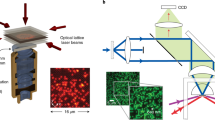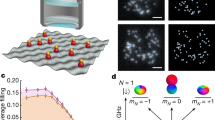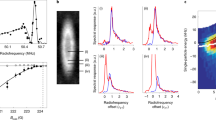Abstract
Measuring the statistical correlations of individual quantum objects provides an excellent way to study complex quantum systems. Ultracold molecules represent a powerful platform for quantum simulation1 and quantum computation2 due to their rich and controllable internal degrees of freedom. However, the detection of correlations between single molecules in an ultracold gas has yet to be demonstrated. Here we observe the Hanbury Brown–Twiss effect—the emergence of bunching correlations of indistinguishable particles collected by separate detectors—in a gas of bosonic 23Na87Rb Feshbach molecules, enabled by the realization of a molecular quantum gas microscope. We detect the characteristic bunching correlations in the density fluctuations of a two-dimensional molecular gas released from and subsequently recaptured in an optical lattice. The quantum gas microscope allows us to extract the positions of individual molecules with single-site resolution. As a result, we obtain a two-molecule interference pattern with high visibility. Although these measured correlations purely arise from the quantum statistics of the molecules, the demonstrated imaging capabilities open the way for site-resolved studies of interacting molecular gases in optical lattices.
This is a preview of subscription content, access via your institution
Access options
Access Nature and 54 other Nature Portfolio journals
Get Nature+, our best-value online-access subscription
$29.99 / 30 days
cancel any time
Subscribe to this journal
Receive 12 print issues and online access
$209.00 per year
only $17.42 per issue
Buy this article
- Purchase on Springer Link
- Instant access to full article PDF
Prices may be subject to local taxes which are calculated during checkout




Similar content being viewed by others
Data availability
Source data can be found in the Harvard Dataverse47. All other supporting data are available from the corresponding author upon reasonable request.
References
Bohn, J. L., Rey, A. M. & Ye, J. Cold molecules: progress in quantum engineering of chemistry and quantum matter. Science 357, 1002–1010 (2017).
DeMille, D. Quantum computation with trapped polar molecules. Phys. Rev. Lett. 88, 067901 (2002).
Brown, R. H. & Twiss, R. Q. A new type of interferometer for use in radio astronomy. Philos. Mag. 45, 663–682 (1954).
Brown, R. H. & Twiss, R. Q. Correlation between photons in two coherent beams of light. Nature 177, 27–29 (1956).
Glauber, R. J. The quantum theory of optical coherence. Phys. Rev. 130, 2529 (1963).
Baym, G. The physics of Hanbury Brown–Twiss intensity interferometry: from stars to nuclear collisions. Acta Phys. Pol. B 29, 1839–1884 (1998).
Henny, M. et al. The fermionic Hanbury Brown and Twiss experiment. Science 284, 296–298 (1999).
Oliver, W. D., Kim, J., Liu, R. C. & Yamamoto, Y. Hanbury Brown and Twiss-type experiment with electrons. Science 284, 299–301 (1999).
Iannuzzi, M., Orecchini, A., Sacchetti, F., Facchi, P. & Pascazio, S. Direct experimental evidence of free-fermion antibunching. Phys. Rev. Lett. 96, 080402 (2006).
Cohen, J. D. et al. Phonon counting and intensity interferometry of a nanomechanical resonator. Nature 520, 522–525 (2015).
Riedinger, R. et al. Non-classical correlations between single photons and phonons from a mechanical oscillator. Nature 530, 313–316 (2016).
Yasuda, M. & Shimizu, F. Observation of two-atom correlation of an ultracold neon atomic beam. Phys. Rev. Lett. 77, 3090 (1996).
Fölling, S. et al. Spatial quantum noise interferometry in expanding ultracold atom clouds. Nature 434, 481–484 (2005).
Öttl, A., Ritter, S., Köhl, M. & Esslinger, T. Correlations and counting statistics of an atom laser. Phys. Rev. Lett. 95, 090404 (2005).
Schellekens, M. et al. Hanbury Brown Twiss effect for ultracold quantum gases. Science 310, 648–651 (2005).
Jeltes, T. et al. Comparison of the Hanbury Brown–Twiss effect for bosons and fermions. Nature 445, 402–405 (2007).
Hodgman, S., Dall, R., Manning, A., Baldwin, K. & Truscott, A. Direct measurement of long-range third-order coherence in Bose-Einstein condensates. Science 331, 1046–1049 (2011).
Perrin, A. et al. Hanbury Brown and Twiss correlations across the Bose–Einstein condensation threshold. Nat. Phys. 8, 195–198 (2012).
Dall, R. et al. Ideal n-body correlations with massive particles. Nat. Phys. 9, 341–344 (2013).
Carcy, C. et al. Momentum-space atom correlations in a Mott insulator. Phys. Rev. X 9, 041028 (2019).
Tenart, A., Hercé, G., Bureik, J.-P., Dareau, A. & Clément, D. Observation of pairs of atoms at opposite momenta in an equilibrium interacting Bose gas. Nat. Phys. 17, 1364–1368 (2021).
Rom, T. et al. Free fermion antibunching in a degenerate atomic Fermi gas released from an optical lattice. Nature 444, 733–736 (2006).
Preiss, P. M. et al. High-contrast interference of ultracold fermions. Phys. Rev. Lett. 122, 143602 (2019).
Köhler, T., Góral, K. & Julienne, P. S. Production of cold molecules via magnetically tunable Feshbach resonances. Rev. Mod. Phys. 78, 1311–1361 (2006).
Tarbutt, M. R. Laser cooling of molecules. Contemp. Phys. 59, 356–376 (2018).
Anderegg, L. et al. An optical tweezer array of ultracold molecules. Science 365, 1156–1158 (2019).
Zhang, J. T. et al. Forming a single molecule by magnetoassociation in an optical tweezer. Phys. Rev. Lett. 124, 253401 (2020).
He, X. et al. Coherently forming a single molecule in an optical trap. Science 370, 331–335 (2020).
Yan, B. et al. Observation of dipolar spin-exchange interactions with lattice-confined polar molecules. Nature 501, 521–525 (2013).
Altman, E., Demler, E. & Lukin, M. D. Probing many-body states of ultracold atoms via noise correlations. Phys. Rev. A 70, 013603 (2004).
Bakr, W. S. et al. Probing the superfluid-to-Mott insulator transition at the single-atom level. Science 329, 547–550 (2010).
Sherson, J. F. et al. Single-atom-resolved fluorescence imaging of an atomic Mott insulator. Nature 467, 68–72 (2010).
Gross, C. & Bakr, W. S. Quantum gas microscopy for single atom and spin detection. Nat. Phys. 17, 1316–1323 (2021).
Wang, F. et al. Formation of ultracold NaRb Feshbach molecules. New J. Phys. 17, 035003 (2015).
Wang, F., Li, X., Xiong, D. & Wang, D. A double species 23Na and 87Rb Bose–Einstein condensate with tunable miscibility via an interspecies Feshbach resonance. J. Phys. B 49, 015302 (2015).
Stöferle, T., Moritz, H., Günter, K., Köhl, M. & Esslinger, T. Molecules of fermionic atoms in an optical lattice. Phys. Rev. Lett. 96, 030401 (2006).
Hutson, J. M. & Le Sueur, C. R. BOUND and FIELD: programs for calculating bound states of interacting pairs of atoms and molecules. Comput. Phys. Commun. 241, 1–8 (2019).
Guo, Z. et al. Improved characterization of Feshbach resonances and interaction potentials between 23Na and 87Rb atoms. Phys. Rev. A 105, 023313 (2022).
Fölling, S. Quantum noise correlation experiments with ultracold atoms. in Quantum Gas Experiments 145–177 (World Scientific, 2014).
Pyzh, M., Krönke, S., Weitenberg, C. & Schmelcher, P. Quantum point spread function for imaging trapped few-body systems with a quantum gas microscope. New J. Phys. 21, 053013 (2019).
Mitra, D. et al. Direct laser cooling of a symmetric top molecule. Science 369, 1366–1369 (2020).
Ni, K.-K. et al. A high phase-space-density gas of polar molecules. Science 322, 231–235 (2008).
Guo, M. et al. Creation of an ultracold gas of ground-state dipolar 23Na87Rb molecules. Phys. Rev. Lett. 116, 205303 (2016).
Büchler, H. P. et al. Strongly correlated 2D quantum phases with cold polar molecules: controlling the shape of the interaction potential. Phys. Rev. Lett. 98, 060404 (2007).
Capogrosso-Sansone, B., Trefzger, C., Lewenstein, M., Zoller, P. & Pupillo, G. Quantum phases of cold polar molecules in 2D optical lattices. Phys. Rev. Lett. 104, 125301 (2010).
Sebby-Strabley, J., Anderlini, M., Jessen, P. S. & Porto, J. V. Lattice of double wells for manipulating pairs of cold atoms. Phys. Rev. A 73, 033605 (2006).
Rosenberg, J., Christakis, L., Guardado-Sanchez, E., Yan, Z. & Bakr, W. Replication data for: observation of the Hanbury Brown and Twiss effect with ultracold molecules. Harvard Dataverse https://doi.org/10.7910/DVN/QTROX3 (2022).
Acknowledgements
We would like to thank G. Zheng, S. Aggarwal, A. Morningstar and R. Raj for experimental assistance. This work was supported by the NSF (grant no. 1912154) and the David and Lucile Packard Foundation (grant no. 2016-65128). L.C. was supported by the NSF Graduate Research Fellowship Program.
Author information
Authors and Affiliations
Contributions
W.S.B. conceived the study and supervised the experiment. J.S.R., L.C., E.G.-S. and Z.Z.Y performed the experiments. J.S.R., L.C. and Z.Z.Y performed the data analysis. All the authors contributed to the article.
Corresponding author
Ethics declarations
Competing interests
The authors declare no competing interests.
Peer review
Peer review information
Nature Physics thanks Hanns-Christoph Nägerl and the other, anonymous, reviewer(s) for their contribution to the peer review of this work.
Additional information
Publisher’s note Springer Nature remains neutral with regard to jurisdictional claims in published maps and institutional affiliations.
Supplementary information
Supplementary Information
Supplementary Sections I–IX, Figs. 1–4 and references.
Rights and permissions
Springer Nature or its licensor holds exclusive rights to this article under a publishing agreement with the author(s) or other rightsholder(s); author self-archiving of the accepted manuscript version of this article is solely governed by the terms of such publishing agreement and applicable law.
About this article
Cite this article
Rosenberg, J.S., Christakis, L., Guardado-Sanchez, E. et al. Observation of the Hanbury Brown–Twiss effect with ultracold molecules. Nat. Phys. 18, 1062–1066 (2022). https://doi.org/10.1038/s41567-022-01695-9
Received:
Accepted:
Published:
Issue Date:
DOI: https://doi.org/10.1038/s41567-022-01695-9
This article is cited by
-
Dipolar quantum solids emerging in a Hubbard quantum simulator
Nature (2023)
-
Probing site-resolved correlations in a spin system of ultracold molecules
Nature (2023)
-
Microscopes go molecular
Nature Physics (2022)



